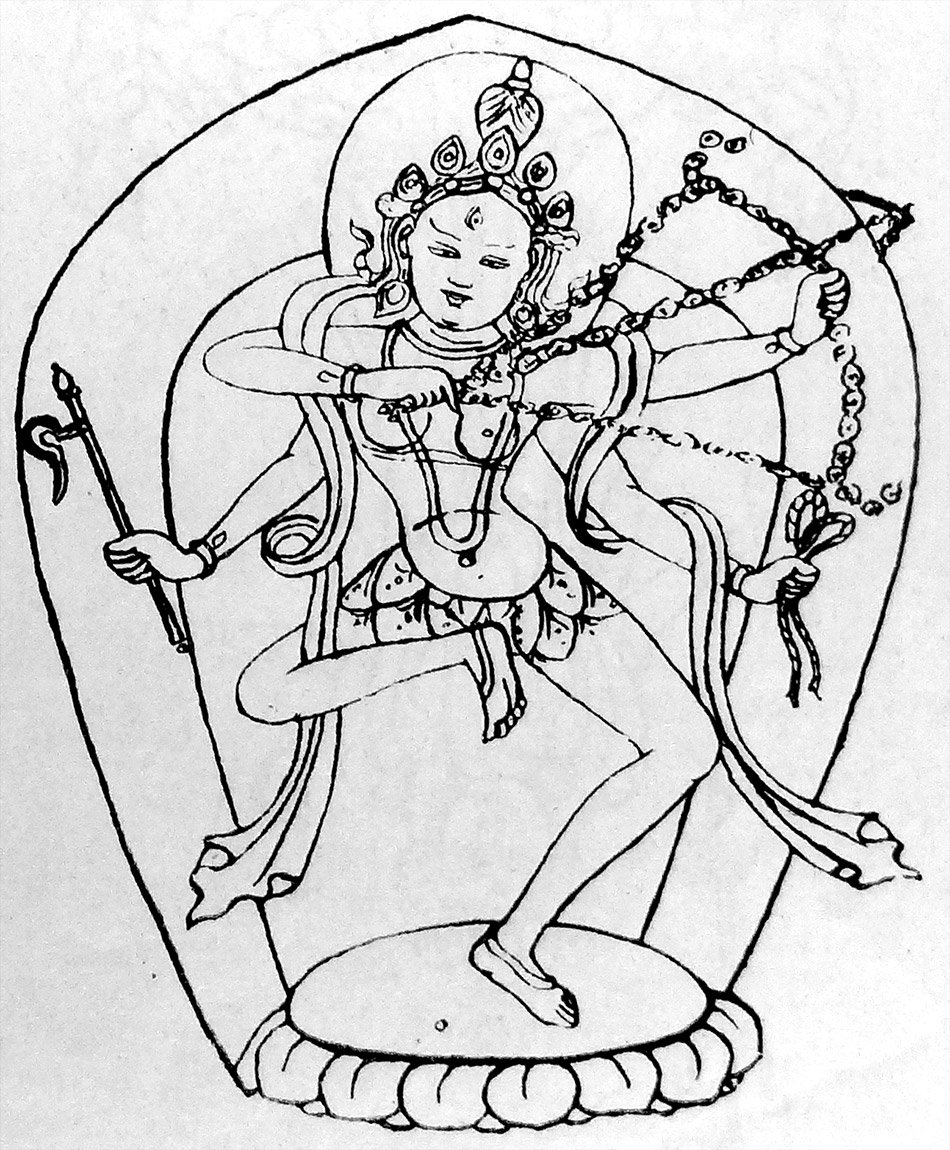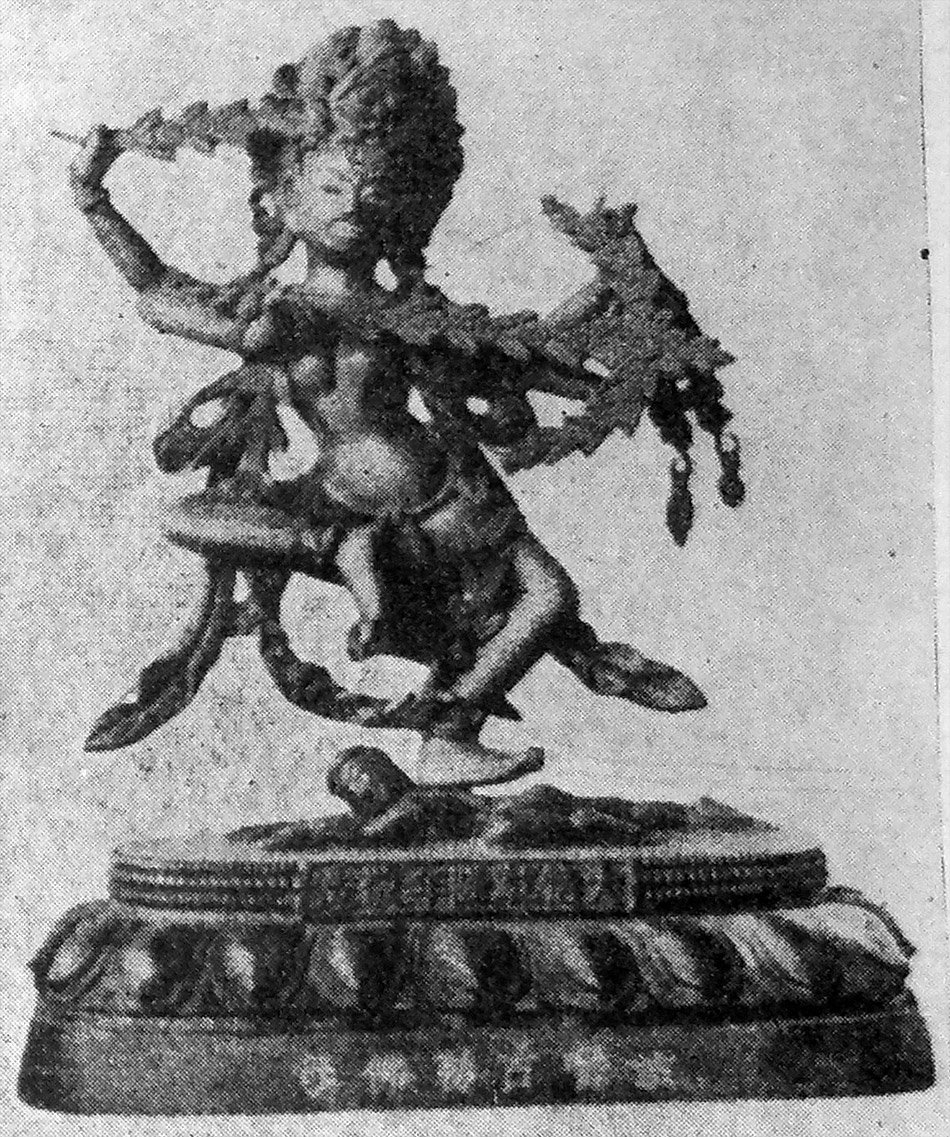The Indian Buddhist Iconography
by Benoytosh Bhattachacharyya | 1958 | 51,392 words | ISBN-10: 8173053138 | ISBN-13: 9788173053139
This page contains an iconography image of Emanations of Amitabha: Kurukulla and represents figure 121-122 of the book Indian Buddhist Iconography, based on extracts of the Sadhanamala English translation. These plates and illustrations represent either photographs of sculptures or line-drawing reproductions of paintings or other representations of Buddhist artwork.
Figure 121-122 - Emanations of Amitābha: Kurukullā
 Figure 121 Kurukullā (Nepalese Drawing) |
 Figure 122: Kurukullā (Peiping) |
Kurukullā is one-faced and may have two, four, six or eight arms. When she is six -armed, she bears the effigies of the five Dhyāni Buddhas on her crown. When two-armed, she is called Śukla Kurukullā, and when she is four-armed she is called by the names of Tārodbhava Kurukullā, Uḍḍiyāna Kurukullā, Hevajrakrama Kurukullā and Kalpokta Kurukullā.
Kurukullā is said to confer success in the Tantric rite of Vaśīkaraṇa or the rite of enchanting men, women, ministers, even kings. Some of the Sādhanas contain many interesting methods of casting spells on different people. The mantra of Kurukullā is “Oṃ Kurukulle Hūṃ Hrīḥ Svāhā”. When this mantra is muttered ten thousand times, all men are bewitched. Thirty thousand times would prove sufficient to subdue a minister, but the subjugation of a king requires no less than a lakh. Kurukullā can even confer on her devotees the power of subduing all ministers and kings.
Images of Kurukullā are found in Tibet ix and China and she is very popular in these countries.
Tārodbhava Kurukullā:
Colour: red;
Arms: four;
Five Sādhanas differing but slightly from one another describe this form of Kurukullā designated as Tārodbhava Kurukullā in the Sādhanas According to the information supplied by the Sādhanas, Tārodbhava is red in colour with red garments, red ornaments and the seat of a red lotus. She has four arms. The two left hands show the Abhaya-mudrā and the arrow, and the two right carry the bow and the red lotus. She sits in the Vajraparyaṅka attitude and under the seat appear Kāmadeva and his wife riding on the demon Rāhu. She has a red aureole behind her, she wears the effigy of Amitābha on the crown, and resides in the Kurukullā mountain. She is in the fulness of youth and displays amorous sentiments. Sometimes she is seen charging a flowery arrow on the flowery bow, ready to strike.
Fig. 121 illustrates a recent Nepalese drawing of the Tārodbhava Kurukullā.
Uḍḍiyāna Kurukullā:
Appearance: terrible;
Colour: red;
Āsana: ardhaparyaṅka;
Vāhana: corpse;
Arms: four;
This form of Kurukullā is called in Sādhanas Uḍḍiyāna Kurukullā or Kurukullā as worshiped in Kurukullā (mod. Vajrayogini). This form of the goddess looks rather fierce, with the garland of heads, the five skulls on the head, protruding teeth and tongue, garments of tiger-skin, and brown hair rising above her head in the shape of a flame. Her eyes, red, round and moving, are three in number. She is four-armed; the principal pair of hands is engaged in drawing to the full the flowery bow charged with an arrow of red lotus, while the second pair holds the goad of flowers and the red lotus.. She is red in colour and sits in the Ardhaparyaṅka attitude on a corpse.
Fig. 122 illustrates one of her statuettes found in Peiping. Here the Vāhana of corpse is present.
